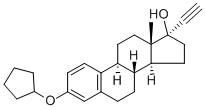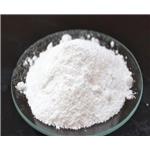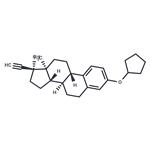Description
Quinestrol is a synthetic estrogen that is effective in hormone replacement therapy. It is a 3-
cyclopentyl ether of ethynyl estradiol. After gastrointestinal absorption, it is stored in adipose tissue, where it is slowly released and metabolized in the liver to its active form, ethinyl estradiol. Quinestrol has found limited use in suppressing lactation in postpartum women and, in combination with synthetic progestogens, as contraceptive therapy, although additional studies are needed for both applications.
References
[1]. baumgardner sb, condrea h, daane ta, et al. replacement estrogen therapy for menopausal vasomotor flushes. comparison of quinestrol and conjugated estrogens. obstet gynecol. 1978 apr;51(4):445-52.
[2]. skouby, s.o. criteria for the selection of an optimal estrogen replacement. gynecological endocrinology 15, 60-67 (2001).
[3]. li j, chen f, li c,et al. quinestrol induces spermatogenic apoptosis in vivo via increasing pro-apoptotic proteins in adult male mice. tissue cell. 2014 oct;46(5):318-25.
[4]. li j, chen f, chen y, et al. mitochondrial- and fas-l-mediated pathways involved in quinestrol induced spermatogenic apoptosis in adult rat testes. toxicol mech methods. 2014 dec;24(9):609-15.





